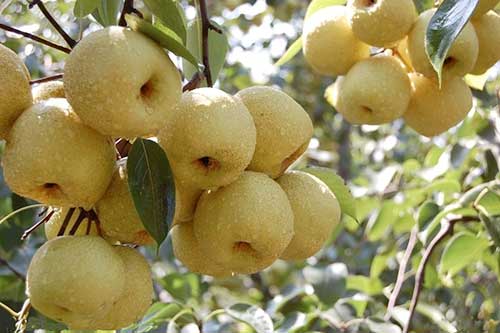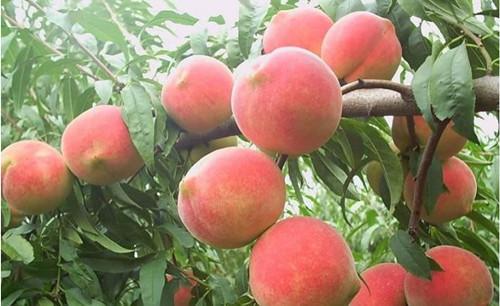Fertilization Techniques for Pear and Peach Trees in Spring
VIEWS: times Release Date:2021-03-13
Pear tree

1. The principle of pear fertilization
(1) Increase the application of organic fertilizers, implement grass growing and mulching in pear orchards, and fertilize the soil; use lime and organic fertilizer to improve the orchards with severe soil acidification.
(2) Determine the fertilizer application period, amount and element ratio according to the yield level and soil fertility conditions. Combine fertilization with high-yield and high-quality cultivation techniques.
(3) According to the soil fertility and the growth status of pear trees, appropriately reduce the amount of nitrogen and phosphorus fertilizers, increase the application of potassium fertilizer, and supplement calcium, magnesium, iron, zinc, boron and other trace elements through foliar spraying.
(4) Optimize the fertilization method, change the spreading application to strip application or hole application, combined with irrigation and fertilization, and adjust the fertilizer with water.
2. Recommendations for fertilizing pear trees
(1) Orchard with a yield of less than 2000 kg per mu: nitrogen fertilizer (N) 8-10 kg/mu, phosphate fertilizer (P2O5) 6-8 kg/mu, potassium fertilizer (K2O) 9-11 kg/mu; orchard with a yield of 2000-4000 kg per mu : Nitrogen fertilizer (N) 10-18 kg/mu, phosphate fertilizer (P2O5) 6-12 kg/mu, and potash fertilizer (K2O) 12-20 kg/mu.
(2) Fertilizer application is divided into 3-5 times. The first time is in mid-May with combined application of nitrogen, phosphorus and potassium; after mid-June, it is recommended to apply topdressing 2-4 times; in the early stage, use nitrogen and potassium fertilizer as the main fertilizer, and gradually increase the amount of potassium fertilizer. It is recommended to apply 20-5-20 formula fertilizer; in the later stage, potassium fertilizer is the main ingredient, with a small amount of nitrogen fertilizer.
(3) For orchards that do not use organic fertilizers in autumn, organic fertilizers should be supplemented and applied as soon as possible after the soil is thawed in spring, using the method of trenching or digging. Orchards with fertile soil, young trees, and strong trees should use 1-2 cubic meters of organic fertilizer per mu; orchards with poor soil, large age, and weak trees should use 2-4 cubic meters of organic fertilizer per mu.
(4) Extra-root top dressing: For pear orchards lacking in boron, zinc, iron, etc., 0.2% borax solution, 0.2% zinc sulfate + 0.3% urea mixture or 0.3% ferrous sulfate + 0.3% urea solution can be used to full bloom before germination. Spray multiple times during flowering, once every other week.
Peach tree
1. Principles of fertilizing peach trees

(1) According to the soil fertility, early, middle and late maturing varieties and yield levels, appropriate amount of organic fertilizers should be added, the application level of nitrogen, phosphorus and potassium fertilizers should be reasonably regulated, and the combined application of calcium, magnesium, boron, zinc and iron fertilizers should be paid attention to.
(2) Different varieties have different topdressing periods in spring. Early-maturing varieties have an earlier top-dressing period than late-maturing varieties and fewer top-dressing times.
(3) Pay attention to the prevention of freezing damage in spring; combined with high-quality cultivation techniques, the plain areas that are prone to waterlogging in summer should be combined with ridging, mulching or orchard grassing techniques; dry areas advocate the use of surface mulch and hole fertilizer storage technology.
2. Recommendations for fertilizing peach trees
(1) Determine the annual fertilizer consumption based on the output level. Yield level is 1500 kg/mu, nitrogen fertilizer (N) 8-10 kg/mu, phosphate fertilizer (P2O5) 5-8 kg/mu, potash fertilizer (K2O) 10-13 kg/mu; output level is 2000 kg/mu, nitrogen fertilizer (N ) 13-16 kg/mu, phosphate fertilizer (P2O5) 7-10 kg/mu, potash fertilizer (K2O) 15-18 kg/mu; yield level 3000 kg/mu, nitrogen fertilizer (N) 16-18 kg/mu, phosphate fertilizer ( P2O5) 10-12 kg/mu, potash fertilizer (K2O) 18-21 kg/mu.
(2) For orchards that do not use organic fertilizers in autumn, organic fertilizers should be supplemented and applied as soon as possible after the soil is thawed in spring, using trenching or digging methods for soil application. Orchards with early-maturing varieties, fertile soils, small ages, and strong trees should apply organic fertilizer 1-2 m3/mu; late-maturing varieties, poor soil, large trees, and weak orchards should apply organic fertilizer 2-4 m3/mu.
(3) The amount of fertilizer application shall be considered uniformly throughout the year. More than 60% phosphate fertilizer, 30%-40% potassium fertilizer and 40%-50% nitrogen fertilizer in chemical fertilizers are best applied together with organic fertilizer in autumn, and the rest is used as topdressing; if the amount of autumn application is insufficient, you can make up for topdressing. Mid-early mature varieties can be top-dressed twice before the peach germination (early March), before the fruit quickly swells, the first application of nitrogen, phosphorus and potassium, and the second application of potassium fertilizer with nitrogen and phosphorus; late-maturing varieties can be applied before germination. During the physiological differentiation period of flower buds (late May to late June), the fruit will be top-dressed 3 times before the fruit expands rapidly. The top dressing before germination is mainly nitrogen fertilizer combined with phosphorus and potassium fertilizer, and the latter two top dressing is mainly potassium fertilizer combined with nitrogen and phosphorus fertilizer.
(4) For peach orchards with excessively high loadings in the previous year, extra-root topdressing should be strengthened this year. 1%-3% urea can be sprayed 2-3 times before germination, and every 7 days after germination until mid-July. Second, spray in the order of 2 times urea and 1 potassium dihydrogen phosphate (concentration 0.3%-0.5%).
(5) The management strategy of "filling deficiencies due to deficiencies" and corrective application is recommended for medium and trace elements. When there is a deficiency of middle and trace elements, it is corrected by foliar spraying.
Previous : Hot Sale Granular NPK 10-20-10+6S Compound Fertilizer
Next : NPK 23:10:5 +6S +1Zn granular compound fertilizer
Latest News
- The company overcame difficulties and won a "good start" in the first quarter ...2022-03-28
- Safe Production ...2022-03-28
- first-line collection ...2022-03-26
- Huaqiang News ...2022-03-26
- Huaqiang Chemical Strong Agriculture Project ...2022-03-25
- huaqiang news ...2022-03-24
- winning unit ...2022-03-22
- Huaqiang News ...2022-03-21
Related Information
- The best fertilizers for fruits and crops ...2020-05-26
- Huaqiang Chemical Group NPK fertilizer pdf ...2020-04-01
- Humic Acid Fertilizer ...2019-12-31
- Bulk Blending Fertilizer ...2019-12-27
- Water Soluble Fertilizer ...2019-12-08
- NPK Fertilizer ...2019-12-02
- Potassium Sulfate Fertilizer ...2019-11-30
- Urea Fertilizer ...2019-11-21
MESSAGE
Our sales staff will be the first time to get in touch with you,to provide you with the latest price.
-
Chemical Products
-
Compound fertilizer
-
Contact Us
Huaqiang Chemical Group Stock Co.,Ltd.
No.1 Jinping Avenue, Dangyang , Hubei , China
Http://www.hq-chemical.com
info@hq-chemical.com
Tel:+86 717 3431866
Mobile: +86 18627120543
© Copyright 2021 Huaqiang Chemical Group Stock Co.,Ltd. All Rights Reserved



